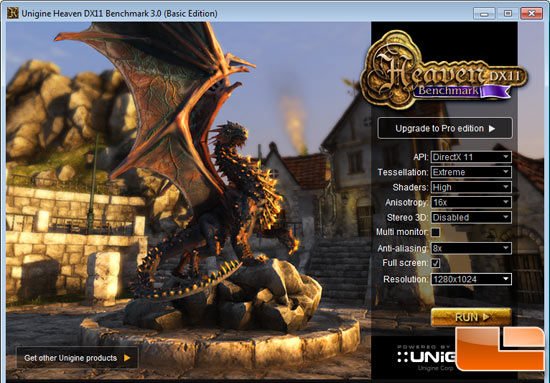NVIDIA & EVGA GeForce GTX 670 2GB Video Card Review
Unigine Heaven 3.0

The ‘Heaven’ benchmark that uses the Unigine easily shows off the
full potential of DirectX 11 graphics cards. It reveals the enchanting
magic of floating islands with a tiny village hidden in the cloudy
skies. With the interactive mode emerging, experience of exploring the
intricate world is within reach. Through its advanced renderer, Unigine
is one of the first to set precedence in showcasing the art assets with
tessellation, bringing compelling visual finesse, utilizing the
technology to the full extent and exhibiting the possibilities of
enriching 3D gaming. The distinguishing feature of the benchmark is a
hardware tessellation that is a scalable technology aimed for automatic
subdivision of polygons into smaller and finer pieces so that
developers can gain a more detailed look of their games almost free of
charge in terms of performance. Thanks to this procedure, the
elaboration of the rendered image finally approaches the boundary of
veridical visual perception: the virtual reality transcends conjured by
your hand.

For this benchmark we used Heaven DX11 Benchmark Version 3.0, which just came out on March 7th, 2012. We haven’t run this benchmark in over a year, so it will be interesting to see how this new generation of video cards handles this benchmark. We wanted to see how the cards would do with mild settings, so we disabled AA and AF and set the Tessellation to moderate. We ran the benchmark at 2560×1600, 1920×1200 and 1280×1024 to see how the cards would perform with a wide variety of settings.

With moderate tessellation enabled and AA and AF disabled the benchmark results were very close. The EVGA GeForce GTX 670 SC held a lead of 2.9% at 1280×1024 and 1920×1080 over the NVIDIA GeForce GTX 670. At a resolution of 2560×1600 the EVGA GeForce GTX 670 SC lost a little bit of ground and the lead dropped to 2.4% over the reference card.

Many feel that tessellation is one of the most important features of game titles today and in the future, so we set tessellation to extreme and maxed out the anti-aliasing at 8x and the anisotropic filtering at 16x. These are as high as you can set the tessellation and image quality settings in Heaven DX11 Benchmark v3.0, so it will really punish these cards.

As you can see performance is less than half of what it was with the previously and the performance between the EVGA GeForce GTX 670 SC and the reference card remained pretty constant. At 1280×1024 and 1920×1080 the difference dropped to 2.7% and 2.5% respectively. Though at 2560×1600 the difference increased to 3.3% instead of the 2.4% we saw above.

Comments are closed.